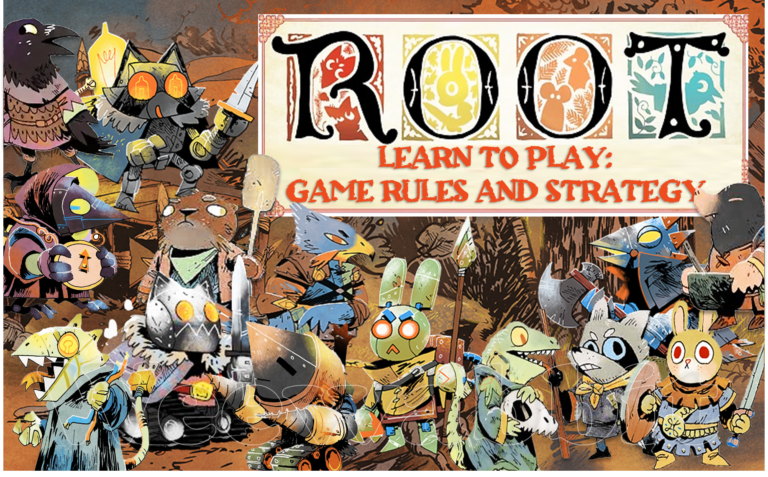This guide is tailored for absolute beginners, specially designed for anyone who’s ever been intrigued by chess but felt put off by its seemingly complex rules. We break down the game into easy-to-understand sections, focusing on the very basics. “WEE” hope to bring the game to life with the help of vivid images and simple videos explanations, turning chess complexity into bite size and easy to digest format for a total beginners. Make learning as engaging as it is simple.
Now, if you already know the BASIC in chess but still consider yourself a beginner, check this one instead..
Otherwise let’s proceed
Let’s start with a bit of “Chess History”.
Chess Brief History
Chess, a strategic board game, has a majestic journey spanning over 1500 years. Originating in India around the 6th century AD, it was initially called “Chaturanga.” This form of the game traveled through Persia, becoming “Shatranj,” and underwent significant changes as it spread across the Arab world and into Europe. By the 15th century, the rules of chess evolved in Spain and Italy to closely resemble the modern game we know today. The game’s timeless appeal lies in its complex strategy and infinite variations, challenging the minds of enthusiasts and professionals alike. Chess has transcended cultures and generations, becoming a global phenomenon that not only entertains but also enhances cognitive skills and decision-making abilities.
Zzzzzz..

Yeah! Yeah! I know sometimes “History” can be… for some.. But we all know it’s essential.
Now let’s be serious. Let’s learn learn Chess, shall we?
The Chess Board and Pieces
First, let’s get to know the battlefield, our chess board.
Chess Board

A chessboard is consists of 64 squares, arranged in an 8×8 grid, alternating between light and dark colors. This would be the battlefield, where you’ll direct your troops, make strategic plans, and execute tactical ideas.
There are terms and significant part of the board that we need to familiarize to fully understand the game of chess, bellow are as follow.
Let’s start with the term “Ranks”.
What are “Ranks” on a Chessboard?
Ranks

Ranks are the rows running horizontally from the perspective of the players. There are 8 ranks on a standard chessboard, numbered from 1 to 8 for white, and 8 to 1 for Black.
Next, we have the term “Files”.
What are “Files” on a Chessboard?
Files

Files are the columns running vertically. These are labeled from “a” to “h”, in whites, and “h” to “a” on black.
Next term is “Flanks”.
What is a “Flanks” on a Chess board?
The term “Flank” generally refers to the board’s sides, the Queenside (left) and the Kingside (right).
Below image shows the two division of our chessboard.

The Queenside, making up the left flank, includes the a, b, c, and d files.
The Kingside, forming the right flank, comprises the e, f, g, and h files.
Flanks

But, when we talk about chess strategy, the “flanks” refer specifically to the board’s outer edges — that’s the a, b, g, and h files.
These edges play a crucial role in chess strategy, serving as key areas for initiating attacks, maneuvering pieces into advantageous positions, and disrupting the opponent’s plans.
Lastly, the most important part of our Chessboard, the “Center Squares”.
Why is the “Center Squares” so important?

The center of the board—the squares d4, e4, d5, and e5—is crucial. It’s like holding the most strategic position in a battle field, giving your pieces the ability to move freely and exert influence across the board. When you control these central squares, your pieces can reach more areas, allowing for powerful attacks and solid defense.
Next, let’s get to know the chess pieces.
Chess Pieces
Since our chessboard is the battlefield, the chess pieces are the noble army that you control. Each with their own roles and special skills, ready to follow your commands.
Let’s meet our noble army.
Each player controls 16 pieces






1 King, 1 Queen, 2 Bishops, 2 Knights, 2 Rooks, and 8 Pawns.
Let’s get to know each one’s roles, rules that governs each, and their movements on the board.
We’ll start with the “King”.

How does the KING move?
The King, arguably the most important piece. Your entire game revolves around the safety of your King. It can move to any adjacent square in a straight line or diagonally, which gives it access to a maximum of eight squares. While his movements are limited to one square in any direction, losing him means losing the battle.
Kings Movement

Next, we have the “QUEEN”.
How does the QUEEN moves?

The Queen, the most powerful piece in your arsenal. The Queen combines the abilities of the Rook and the Bishop. It can move any number of squares along a rank, file, or diagonal. Her flexibility makes her a strong ally, but also a piece your opponent will be eager to threaten.
Queens Movement

Next is our “BISHOPS”.
How does the BISHOP moves?

The Bishop moves diagonally across the board. Each bishop starts on one color and remains on that color throughout the game, working in tandem to control both light and dark squares.
Bishops Movement

Then we have our noble “KNIGHTS”.
How does the KNIGHT moves?

The Knights, symbolized by the horse, have a unique movement. Unlike other pieces, Knights is the only one that can “jump” over other pieces, making their movements slightly trickier to anticipate. A Knight moves in an L-shape, two squares in one direction and then one square perpendicular, or vice versa. This flexibility often allows Knights to control a good number of squares in the center of the board.
Knights Movement

Next is our “ROOKS”.
How does the ROOK moves?

Rooks, on the other hand, moves in a straight line horizontally or vertically in any number of squares it occupies but cannot jump over other pieces. They control open lines, working best when they coordinate with each other.
Rooks Movement

Lastly, our frontline army, the “PAWNS”.
How does the PAWN moves?

Lastly, we have the Pawns, your loyal foot soldiers. At first glance, they may seem less significant, but a pawn move can often dictate the flow of a chess game. They move one square straight forward (never backward), but capture diagonally. Pawns can choose to move two squares forward, only on its first move.
They might be small, but they’re pivotal in maintaining central control of the board.
Pawns Movement

The Pawn can choose to move 2 spaces forward on its first move (ONLY ON THE FIRST MOVE). Pawn captures diagonally.
Next, we’re going to learn how to name every single square on our chessboard, your key to becoming a chess master.
How to Identify Every Square
Now that we’ve explored the different parts of the chessboard and met all the chess pieces, let’s take a closer look at the chessboard itself. Each square on the board has a special name, like a unique address where each piece can move, capture, or defend. Understanding how to identify these squares will turn you into a more strategic player, helping you plan your moves more precisely and communicate your game plans clearly. Let’s learn how to find and name every square on the chessboard.
Trust me, this is very important. You’ll be thankful later, knowing this.
Remember the “Files” and the “Ranks” we have discussed early?

Each File is labeled with letters from
“a” to “h”

Each Rank is labeled with numbers from
“1″ to “8″
Combining both will give us the name of every squares.
To identify a specific square, combine the file letter and the rank number. This system allows players to precisely pinpoint each square on the board. Below are 4 examples.
For our 1st example, let’s pinpoint “d5”
d5
The square at the intersection of the “d” file and the “5” rank is “d5.”

Next, let’s pinpoint “h8”
h8
The square at the intersection of the “h” file and the “8” rank is “h8.”

For our 3rd example, let’s pinpoint “b3”
b3
The square at the intersection of the “b” file and the “3” rank is “b3.”

Lastly, let’s pinpoint “f6”
f6
For example, the square at the intersection of the “f” file and the “6” rank is “f6.”

Basically, to get the name of the square we combine File and Rank (Letters and Number).
The name of the square is where File and Rank intersects.
Here is “WEE” to give you a simple explanation.
Here’s a chessboard with name assign for each square just in case you need to study more.

It’s very easy, right? Think of it as knowing the address of every spot where your pieces can go. It’s more like a map that would make navigating the battlefield, our chessboard, a lot easier.
Now that we are familiar with our Chessboard, our Pieces, and named every square in the board, It’s time to line up our chess pieces.
Initial Set-up

When setting up a chessboard for a new game, it’s crucial to get the initial arrangement of the pieces correct, as it lays the foundation for the entire game.
Here are some key points to remember:
1. White on Right

The board should be set up so that each player has a white (or light) square at the bottom-right corner of the closest rank. This is often summarized as “white on right.”
2. Rook Placement

Rooks are placed at the corners of the board, on the far left and right square, for both players.
3. Knight Placement

Knights are positioned next to the rooks. They go on the “b” and “g” files
4. Bishop Placement

Bishops take their places next to the knights, on the “c” and “f” files.
5. Queen On Her Color

Always remember, the queen is always placed on her color, the
White queen on a white square and black queen on black or dark square. The king takes the remaining square next to the queen.
6. Pawn Lineup

All eight pawns are placed directly in front of the other pieces, on the second rank of the white players, and the 7th rank for black.
Our chessboards’ all set up! Let’s go over the main objective of the game.
Check, Checkmate, and Stalemate
The terms “check,” “checkmate,” and “stalemate” are essential to understand for any aspiring chess player. These concepts are at the core of chess strategy and focus on the position and safety of the king, which is central to the outcome of every game.
First, let’s define “Check“.
What does the term “Check” means?
“Check” is a term used to indicate that a king is under immediate threat of capture. When a king is in check, it means that one of the opponent’s pieces is attacking it.
And how about Checkmate?
What does a “Checkmate” mean?
The term Checkmate occurs when a king is in “check” (under threat of capture) and there is no legal move available to escape the threat. This situation ends the chess game, with the player whose king has been checkmated losing.
Checkmate is the ultimate aim in the game of chess, it concludes the game. There is no continuation from checkmate, the game is immediately over, and the player that delivered the checkmate wins.
Pieces Working Together To Checkmate

There are instances where you can checkmate an opponent with a single piece. But, Checkmate is often achieved by multiple pieces working together as a team.
In chess, each piece has its own unique moves. By working together, pieces can cover more squares and create stronger threats. Combining pieces allows you to control different areas of the board, making it harder for your opponent to defend and escape.
Let’s see an instance how a single piece checkmate an opponent…
What is a Back Rank Mate?

The Back Rank Mate is a common checkmate pattern that occurs when a player’s king is trapped on its original row (the back rank) with little to no defensive pieces, usually pawns, in front of it.
Here’s a short clip on how a Back Rank Mate works.
It’s a powerful checkmate pattern and serves as a reminder of why it’s important not to leave the back rank undefended, especially if there’s a clear path for the opponent’s rook or queen to invade.
What is Smothered Mate?

The Smothered Mate is a dazzling checkmate that often happens with a knight, supported indirectly by other pieces, delivering the final blow to a king that is unable to escape because it is surrounded by its own pieces.
Here’s a short clip to show how Smothered Mate works…
The Smothered Mate is one of the most satisfying and elegant checkmates in chess because it uses the unique abilities of the knight to full effect and often involves clever tactics leading up to it.
Queen and Bishop Mate

The Queen and Bishop Mate is a classic checkmate pattern where the queen and a bishop work in tandem to deliver a checkmate. This pattern often exploits the long-range powers of both pieces, with the bishop controlling a diagonal and the queen controlling the adjacent rank or file.
Let’s look at how powerful a Queen and Bishop tandem on this video clip of Queen & Bishop Mate.
Unlike some other checkmate patterns, the Queen and Bishop Mate often does not allow for an opponent’s piece to block the threat. This type of mate is most effective when the opponent’s king has limited mobility, often toward the edge of the board or when other pieces are blocking potential escape squares.
Lastly, let’s define Stalemate.
What does “Stalemate” mean?
Stalemate occurs when a player cannot make any legal moves and their king is not under check. This results in a draw, ending the game without a winner. It typically happens when the king is blocked by other pieces and cannot move.
Draws: The Fifty-Move Rule and Perpetual Check
In chess, there are specific rules that can end a game in a draw, meaning neither player wins. Two examples of these rules are the fifty-move rule and perpetual check. Both prevent the game from dragging on forever without any significant moves or chances to win.
What is the Fifty-Move Rule?
The fifty-move rule in chess states that a game can be declared a draw if fifty consecutive moves have been made by each player without any pawn movement or capture. This rule helps to avoid situations where a game might be unnecessarily prolonged, preventing players from continuing indefinitely in the hope that their opponent will make a mistake or simply out of fatigue.
What is Perpetual Check?
Perpetual check occurs in chess when one player repeatedly checks the opponent’s king in a sequence that the opponent cannot escape without ending the game. While perpetual check itself doesn’t automatically result in a draw under current rules, it typically leads to a draw by repetition. This happens because the checks continue without end, causing the game to loop through the same positions.
These rules ensure that games don’t stretch on indefinitely without progress, providing a fair resolution in otherwise stalled situations.
Do you know, there’s some special moves in chess that are totally awesome?
Special Moves
Chess isn’t just about moving pieces in straightforward paths. There are a few special moves that can give you surprising advantages and add depth to the game. These moves are like secret weapons that, when used at the right moment, can turn the tide of a match. Let’s explore these moves to give you more tools in your chess toolkit.
First one on our list is Casling or Castle.

Castle
Castling is a special move in chess that involves the king and either one of the player’s rooks. It is the only move in chess that allows two pieces to move at the same time, and it serves two strategic purposes: protecting the king and activating the rook.
How does “Castling” works?
To castle, you move your king two squares towards one of your rooks. Then, move that rook to the square immediately next to the king on the opposite side.
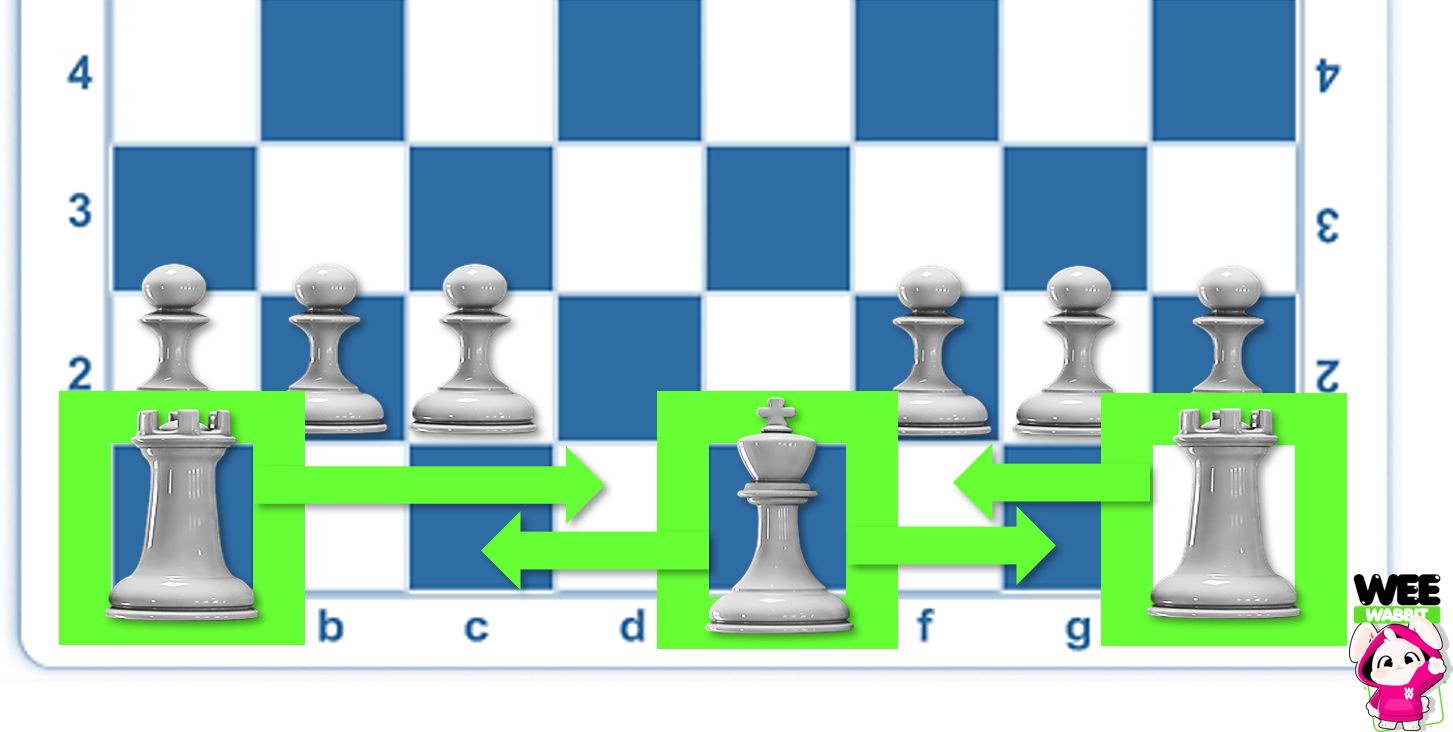
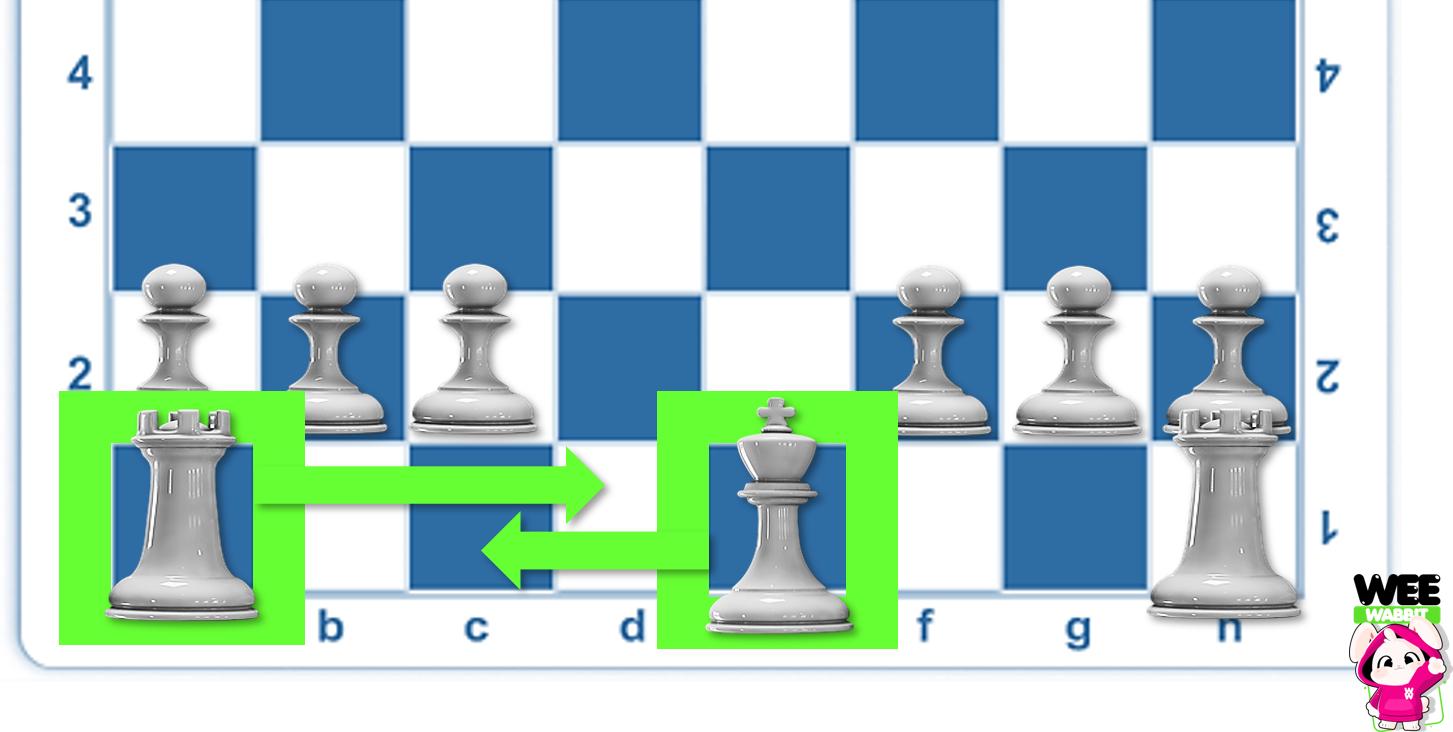
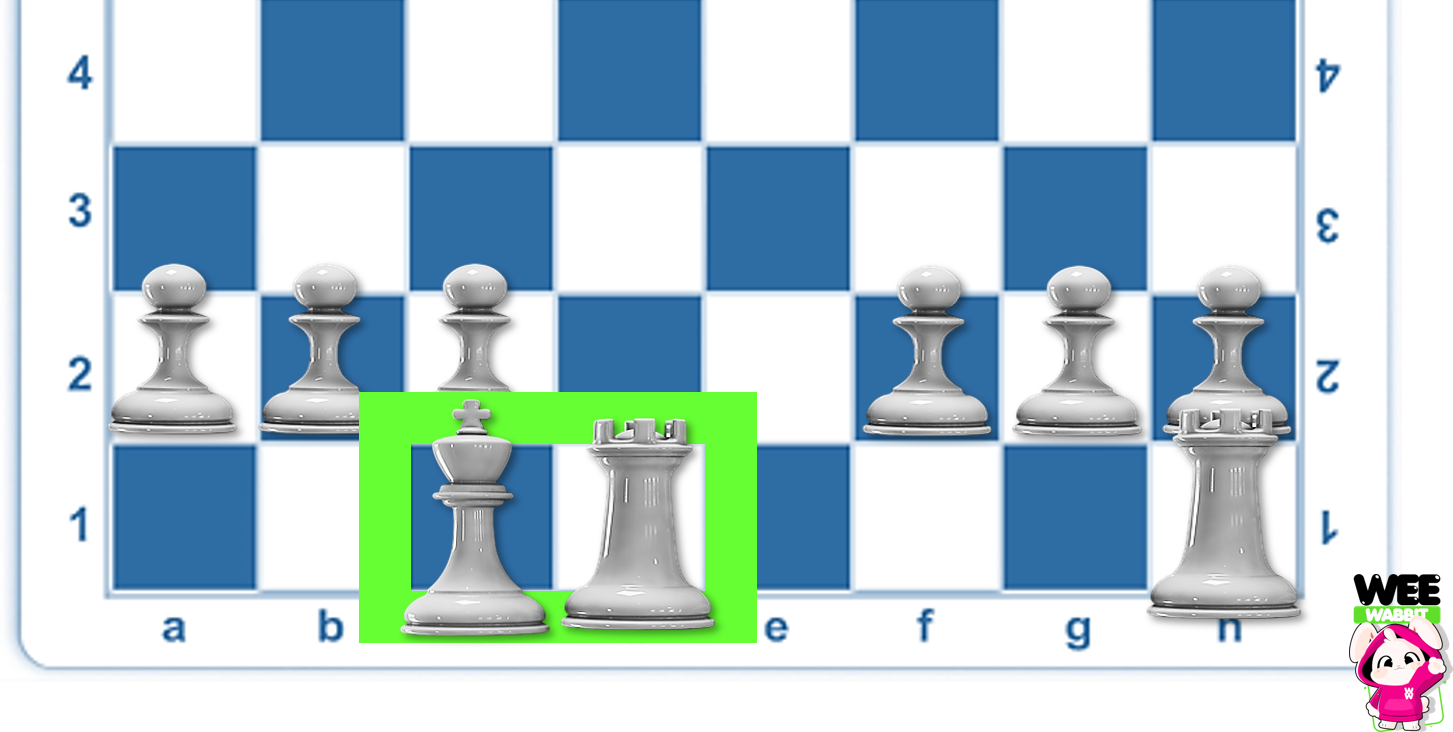
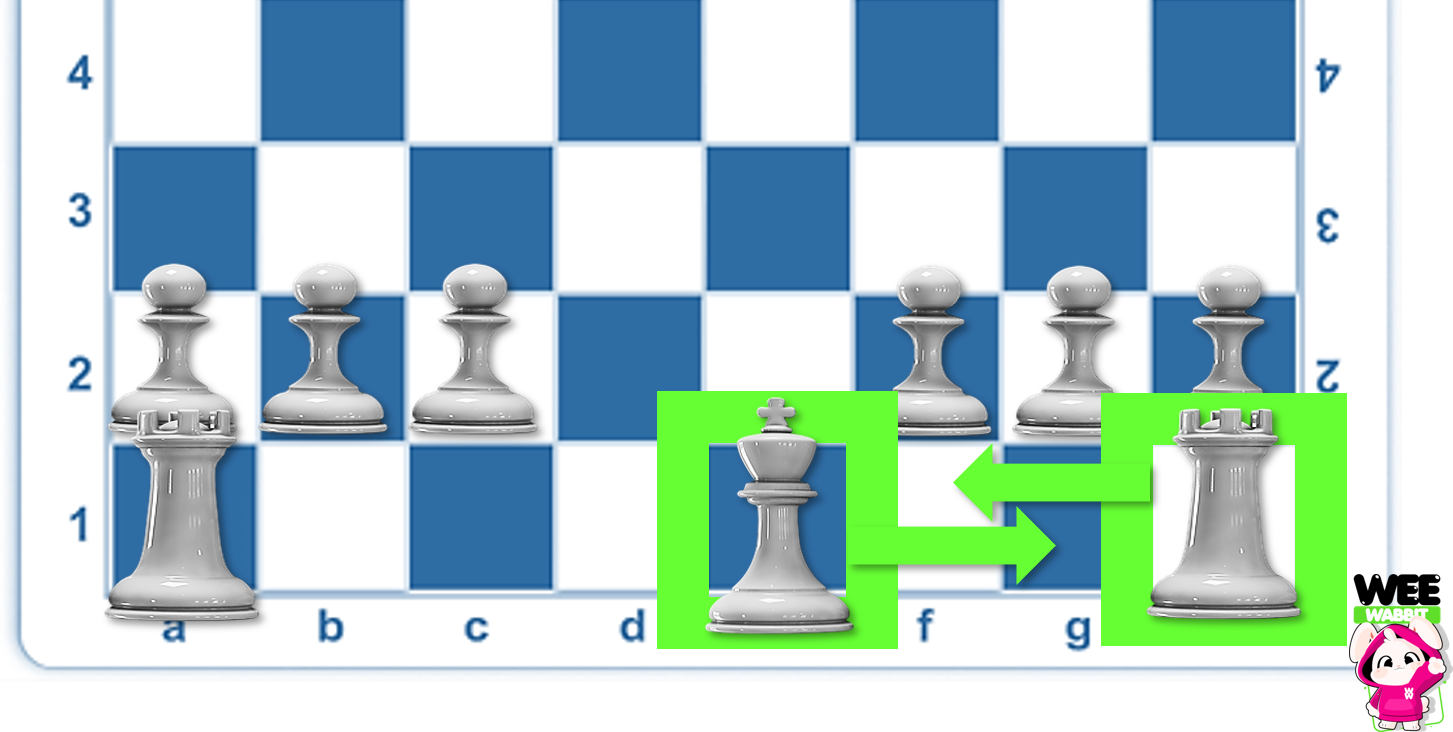
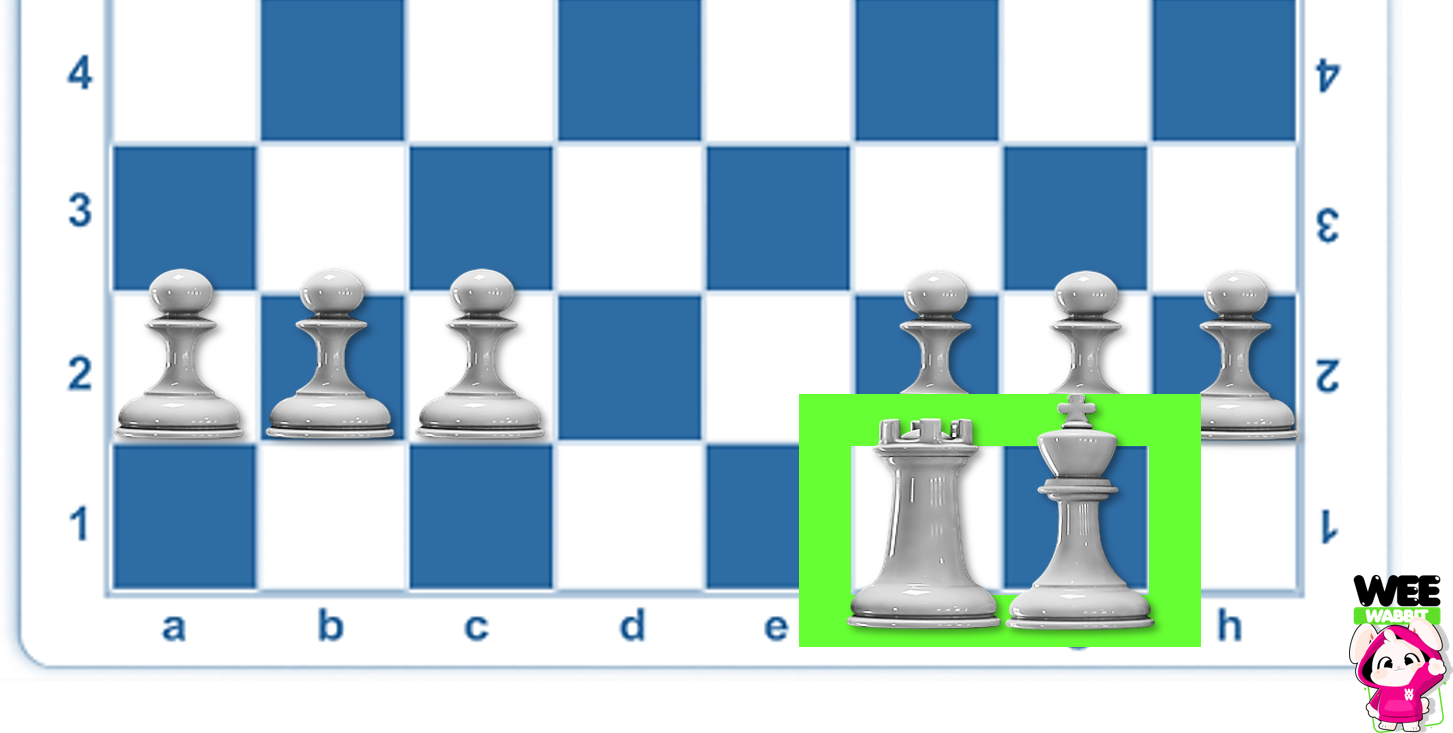
Remember the 2 side of the board we’ve learned earlier, the Queen side(left flank) and the King side(right flank)? You can castle on either side but only once.
Queen side castle (Left)
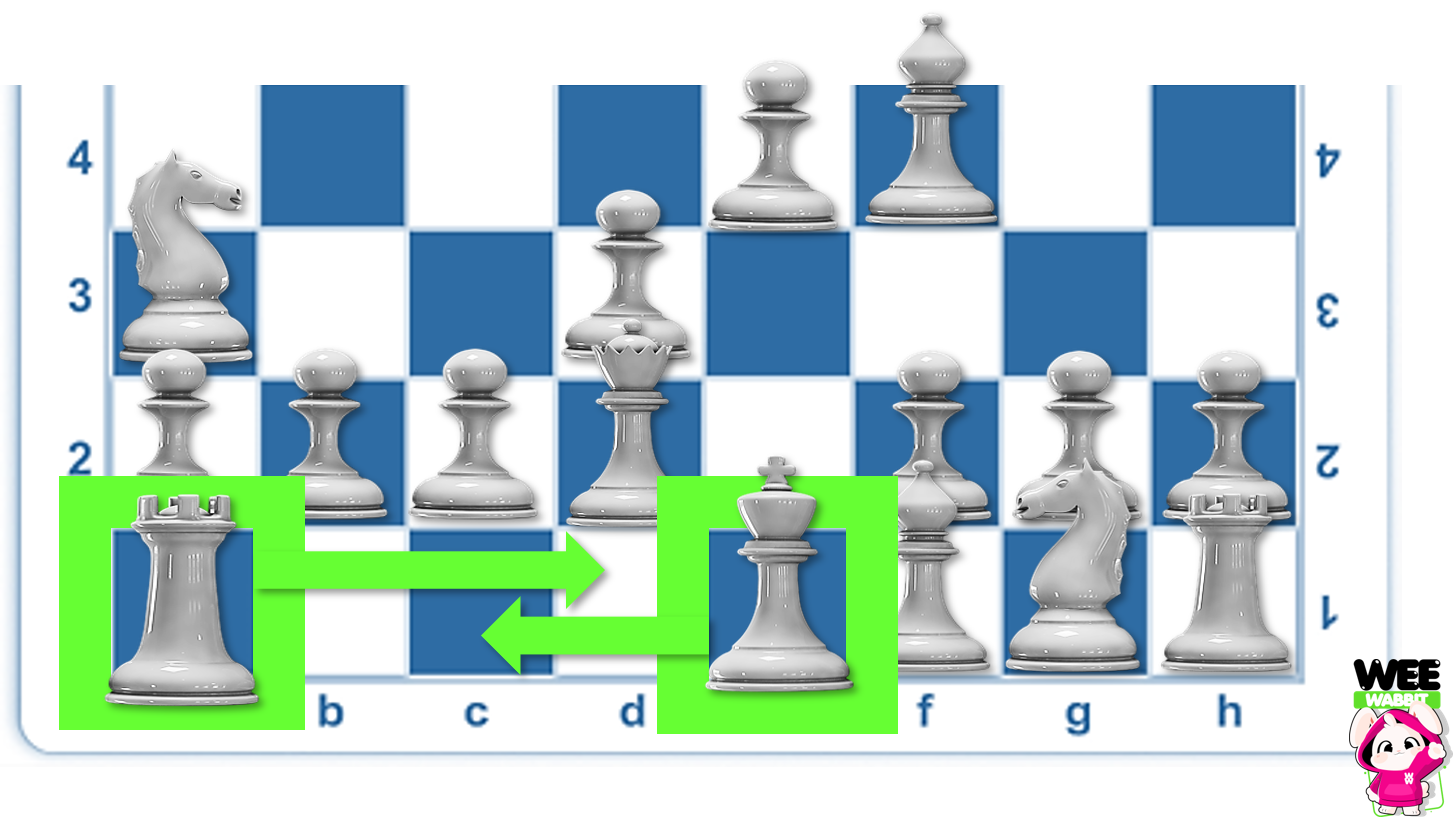
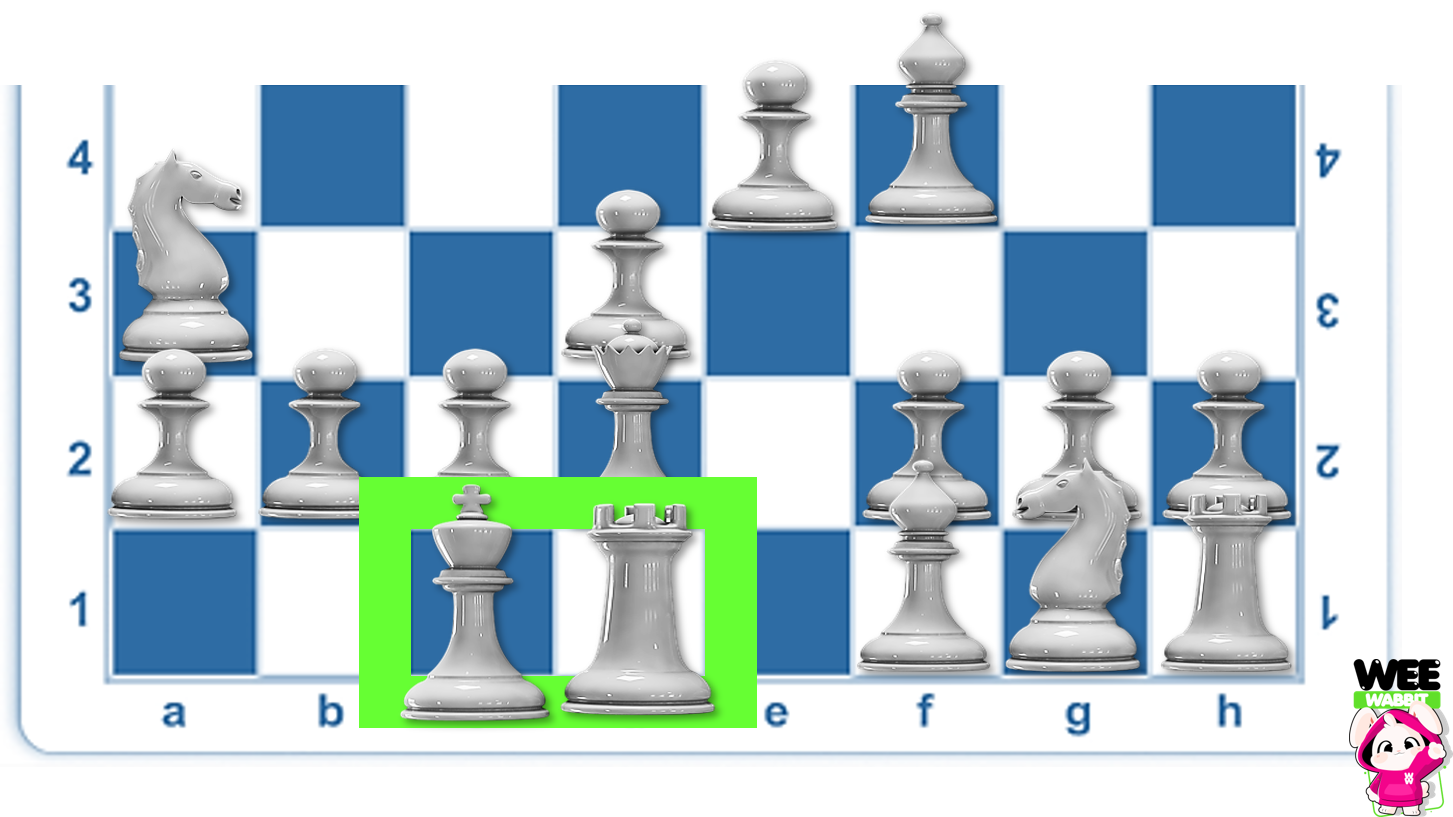
King side castle (Right)
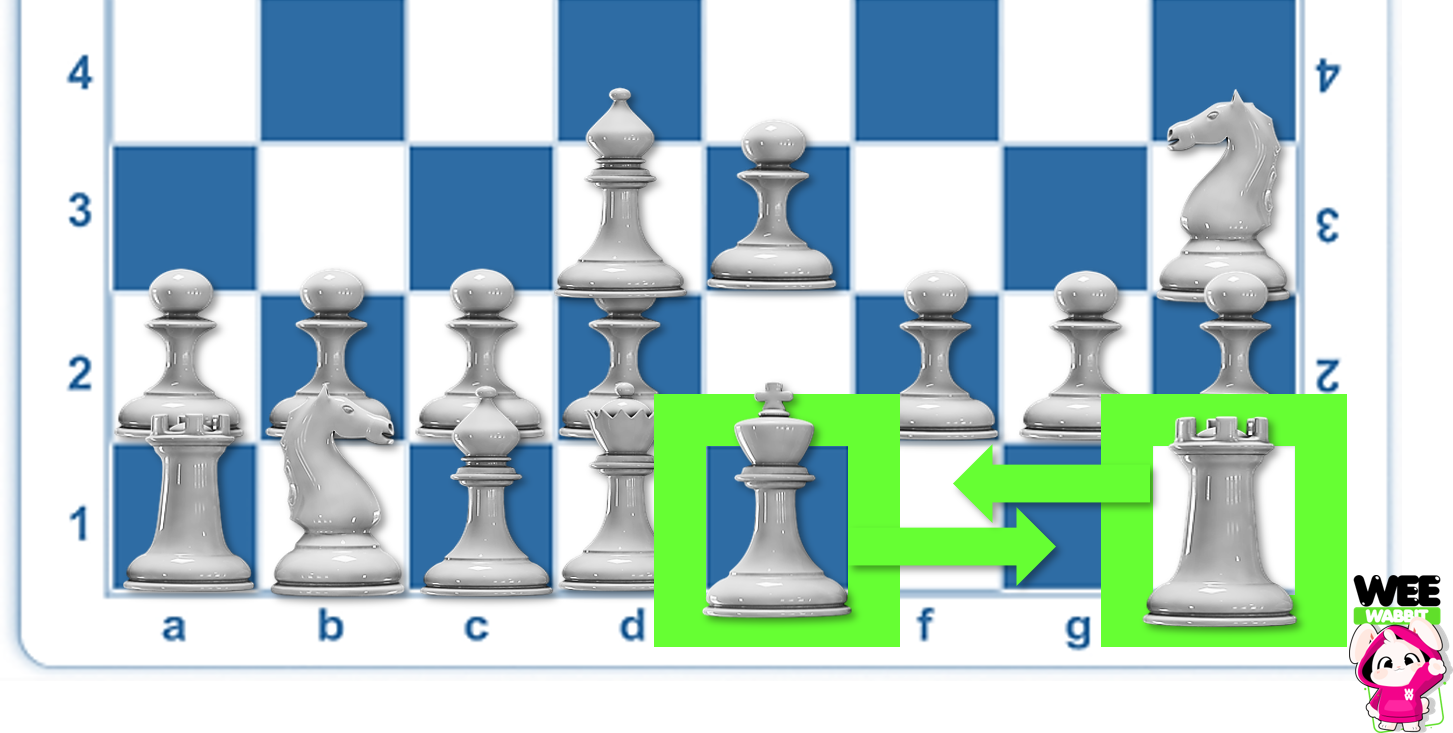
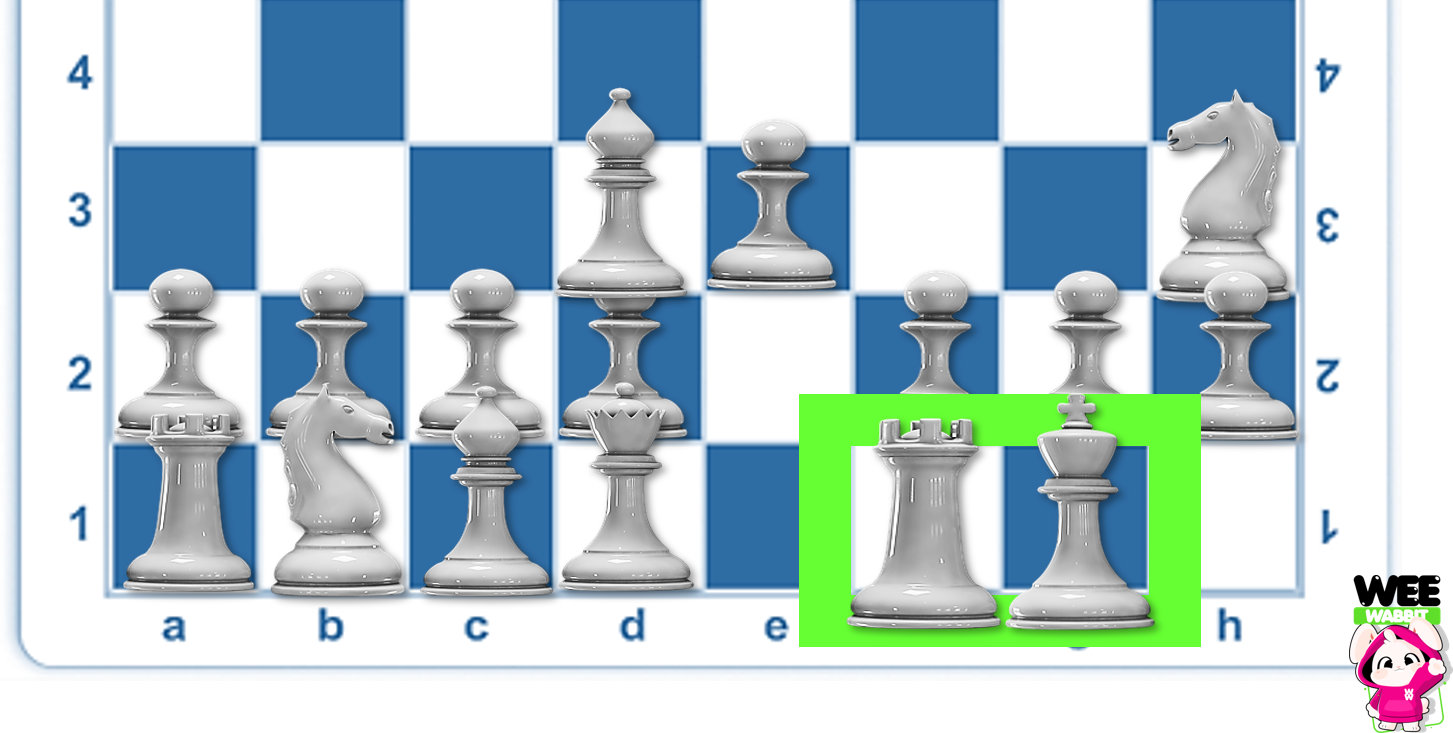
But in order for us to castle, we need to follow some specific conditions or requirements.
Rules for Castling
To castle, below are the 3 conditions that should be met..
1. No Pieces Between

There must be no pieces between the king and the rook.
It means, Castling can only occur if there are no pieces between the king and the rook.

If there are no pieces between the King and the Queenside(left) Rook, you can Castle here.

If there are no pieces between the King and the Kingsideside(right) Rook, you can Castle here.
You can castle either way as long as there’s no pieces in between, and as long as…
2. Neither Piece Has Moved

Neither the king nor the rook involved in castling may have moved earlier in the game.
It means, Once the King or any of the Rook has moved from their original position at any point in the game, you lose the right to castle.
(even if you move it back to its original position)
And lastly…
3. No Checks
You cannot castle “out of a check”, and “into a check”.

The King can’t castle to escape a check.

The King can’t castle if it will land on a check.

If the square where the Rook ends up after castling is under attack, the castling move is still allowed. The rule only applies to the path and final position of the king, not the Rook.
Here’s another one, En Passant. This one is like magic.

En Passant
En Passant is a special pawn capture move in chess that many beginners find a bit puzzling initially. It’s a unique rule that allows a pawn to capture another pawn in a way that seems to defy the normal rules of how pawns capture.
How does “En Passant” works?
There’s no easier way of explaining En Passant but to show you how in action, here’s a small clip explaining how En Passant works.
It’s so cool, right!?
Now, do you know you can have 2 Queens? How about getting a new Queen if yours got captured early in the game? Yap! You can through...

Pawn Promotion
When a pawn reaches the opposite side of the board, it can be promoted to any other piece, usually a queen, which is the most powerful piece.
So, if yours got captured early in the game, you still have a chance to get another one. And if you still have yours and one of your pawns reached the other side of the board, you can promote that pawn to another Queen.
Pawn promotion
How a humble Pawn gets promoted.
As an aspiring chess master, let’s go over the…

Unspoken Rules of Chess

Besides knowing how to move the pieces and play the game, there are some unwritten rules that players usually follow to show good manners and respect for each other.
Here’s a look at these important etiquette tips.
- Shake Hands: Before and after the game, players often shake hands. This is a way to show good sportsmanship, no matter if you win or lose.
- Quietly Announce Check: It’s a nice gesture to quietly say “check” when attacking the opponent’s king, especially in friendly games. It helps keep the game respectful and fair.
- Avoid Distractions: During the game, try not to do things that could distract your opponent, like talking, making noise, or moving around too much.
- Touch-Move Rule: If you touch a chess piece, you need to move it if you can(this is actually part of the official rules in formal settings). If you just need to fix a piece on its square, say “adjust” first, so your opponent knows you’re not making a move.
- Play Promptly: When it’s your turn, try to make your move without taking too long, especially in games with a clock. This keeps the game moving and is polite to your opponent.
- Respect the Equipment: Treat the chess pieces, board, and clock gently. Avoid banging pieces down or hitting the clock too hard.
- Resign Gracefully: If you’re losing and there’s no way to win, it’s often better to resign the game than to keep playing without any hope of winning. Just stop the clock and shake hands.
- Keep Celebrations Quiet: If you win, it’s best not to celebrate too much right at the chessboard. It’s more respectful to be calm and discuss the game gently if both players want to.
- Maintain a Neutral Expression: Try not to show too much emotion during the game, whether you’re winning or losing. Keeping a steady face helps keep the game focused on skill.
- No Outside Help: Never get help from books, devices, or people watching the game. It’s cheating and goes against the spirit of chess.
Following these etiquette rules can make playing chess more enjoyable and shows you respect your opponent and the game itself.
New to Chess, we can’t just jump in with all its complexity. Let’s just start simple.
Chess Strategy for First-Time Players
The best way to start Chess is by getting a feel for how each piece moves on the chessboard and using what we’ve learned so far. As a first-time player, our game plan focuses on understanding the basics and getting comfortable with the mechanics of the game.
For now, as a first-timer, let’s just focus on 5 goals.
1. Learn How Each Piece Moves
Start by moving each chess piece around the board. Learn how pawns push forward, how knights jump in an L-shape, how bishops glide diagonally, rooks cruise straight across rows and columns, and how the queen can move in any direction she wants.
2. Control the Center
Try to move your pieces into the center squares of the board (like e4, d4, e5, d5). This is a great way to see how powerful your pieces can be when they control the middle of the board.
3. Clear a Path for Castling
Try to move your knights and bishops out from their starting positions. This does two things: it helps you practice using these pieces and clears the way to castle your king. Castling is a key move where you get to tuck your king away safely and bring a rook into play.
4. Aim for a Pawn Promotion
Try to send at least one pawn all the way to the other side of the board. When a pawn reaches the far end, it can turn into any other piece, usually a queen. This is a cool rule that shows how a simple pawn can become the game’s most powerful piece!
5. Practice Basic Checkmates
Learn a few basic checkmate patterns, such as using two rooks or a queen and a king to checkmate the opponent’s king. Practicing these patterns will not only give you a clear goal to aim for during games but also improve your understanding of how pieces can work together effectively.
Your first few games should be about exploring and trying things out, not just about winning. This is the best way to learn the moves and start thinking about different strategies.
In case you haven’t got your very own, here’s some beginner friendly Chess Set…
Choosing the right Chess Set
Choosing the right chess set can greatly enhance your learning experience as you begin your journey into the world of chess. WEE compiled a list of chess sets that are perfect for beginners, each selected for its quality, ease of use, and value.
First on our list is…
Chess Teacher

The Cardinal Classics “Teacher Set” is an excellent resource for beginners, offering a clear and instructive introduction to the game of chess. With each piece displaying its name and movement options, the set facilitates a straightforward understanding of how to play, making it a valuable tool for novices to develop their skills.
Next 2 on our list are good choices for our young aspiring chessmaster…
Quick Chess

Quick Chess provides a seamless introduction to chess with an award-winning, activity-based system. Designed to simplify learning, it breaks down the game into 8 enjoyable activities that progressively build chess knowledge. The set not only covers the basics but also hones critical thinking and problem-solving abilities. With a board that flips to transition to traditional chess, Quick Chess is an ideal step for beginners.
Story Time Chess

Story Time Chess brings the classic game of chess to life for the youngest of players. With its unique approach that weaves chess rules into engaging stories, it’s perfectly designed for children as young as three, requiring no previous chess knowledge from the child or parent. It offers over 30 mini-games, a storybook illustrated by a former Disney illustrator, and dual-sided pieces for regular or tournament play. Winning numerous awards including the 2021 Toy of The Year People’s Choice, Story Time Chess is celebrated for making the learning process as magical as the game itself.
Then we have…
Bobby Fischer® Learn to Play Chess Set

The Bobby Fischer Learn to Play Chess set is an excellent educational tool for aspiring chess enthusiasts. Recognized with awards for its effectiveness as a learning game, it features a board with images that guide piece setup and movement, alongside algebraic notation for teaching. The set includes plastic Staunton pieces suitable for tournament play and a comprehensive instruction book with advanced strategies and historical context. With the inclusion of equalizer dice, it offers a balanced challenge for players of varying skill levels, making it ideal for both kids and adults.
Lastly, on the tech department, we got...
Femuey Electronic Chess Sets

This Chess Set is a cutting-edge tool for both learning and enhancing chess skills. Designed with multiple difficulty levels and a comprehensive library of exercises and opening moves, it is suitable for beginners and experienced players alike. The set’s interactive lights display possible moves, providing a clear and engaging way to understand the game’s intricacies without distraction. Its portable design ensures that it’s an excellent choice for use at home or on the go, catering to all age groups with its magnetic, easy-to-store pieces.
This by far is our best choice compared to other electronic chess in the market that is beginner-friendly.

WEE Wrapping-Up
Chess may seem intricate and complex, but do know that each chess master’s journey began with a single move, much like the ones you’re about to make. Each chess master started as a beginner just like you. It’s a game of learning and discovery. Take your time, enjoy each play, and know that with every piece you move, you’re unlocking a little more of the chess magic.
And this concludes our Introduction to Chess. WEE hope this simple guide can be as helpful and enjoyable to your chess journey. Do come back soon for more simple guides and chess strategy, and let WEE guide you along the way.





